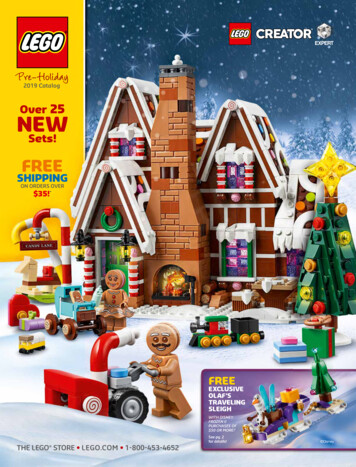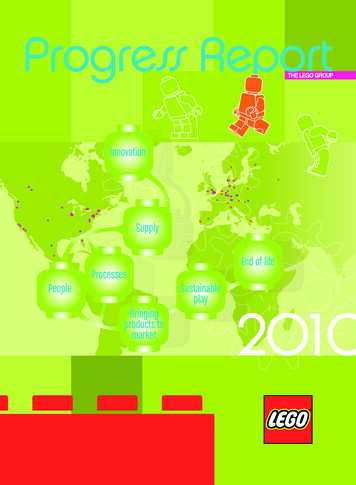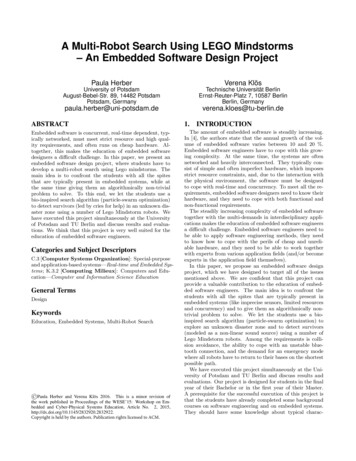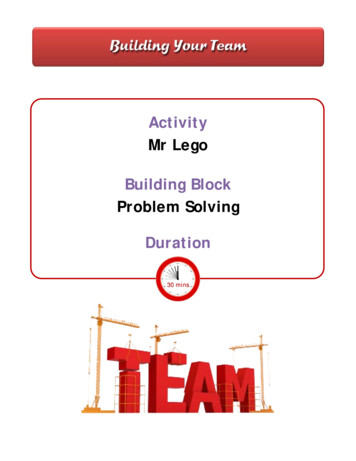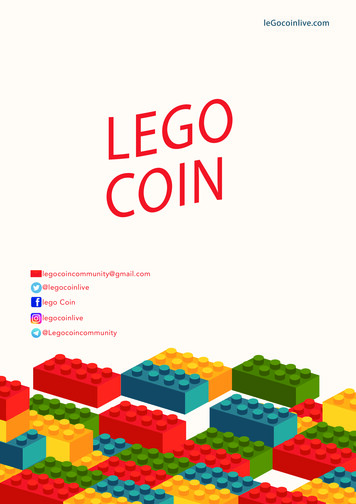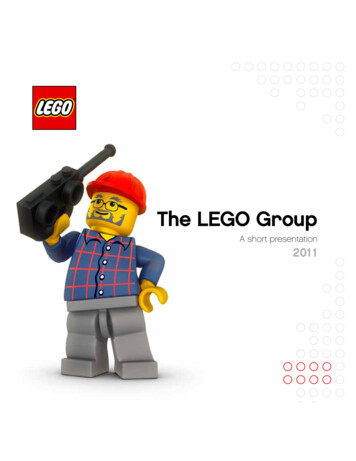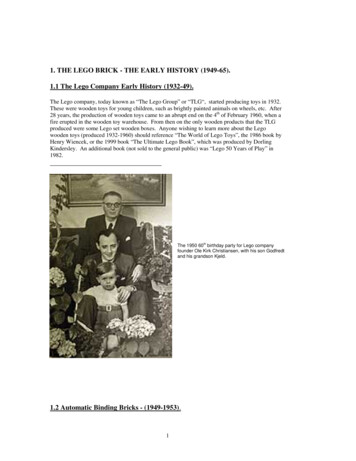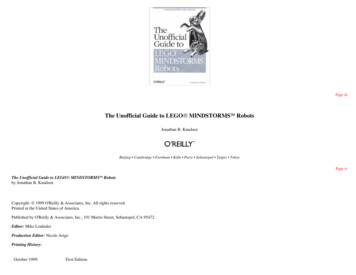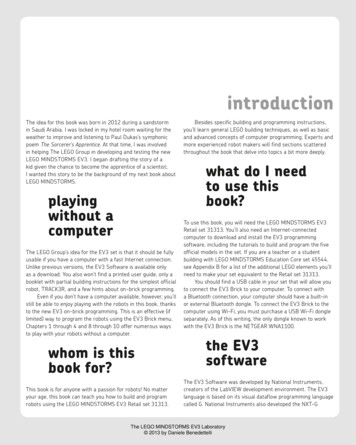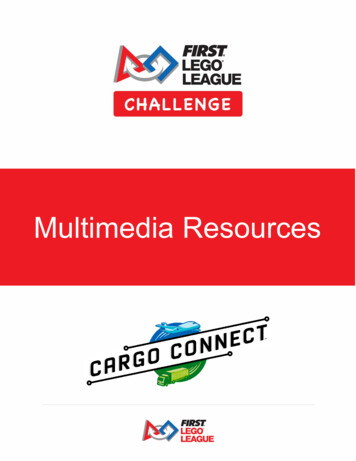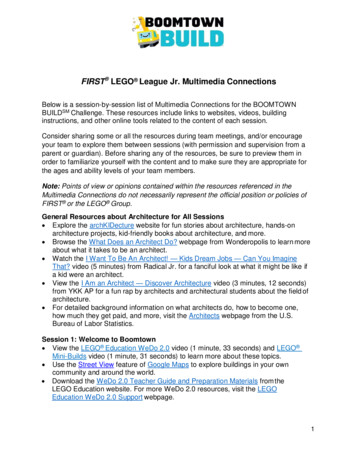
Transcription
REBRANDING LEGO1BSc (IM) 6th semester, Bachelor ThesisAuthors: Binh Thi LeSupervisor: Berit KampREBRANDING LEGO.AN ANALYSIS OF CAUSES AND SOLUTIONSIMPLEMENTED.Department of Marketing and StatisticsAarhus School of Business[02nd May 2011]
REBRANDING LEGO2AbstractThis paper describes the seven-year rebranding process undergone by the LEGO Group inbetween 2004 and 2010. In the first part of the paper there is a focus on describing the relevantliterature concerning the branding and rebranding concepts while the second part of the paperdeals with the LEGO case study. The rebranding process (called “Strategic Vision” by the LEGOGroup) is described from start to finish and is broken down in its three phases. The four cyclemodel of corporate branding is presented as well as the VCI Alignment model. The paperconcludes that the rebranding process was a lengthy and demanding endeavor that consisted ofimplementing various successful solutions to several brand problems.
REBRANDING LEGO3Table of contentsIntroductionMotivation.4Problem statement.4-5Research questions.5Methodology.6Delimitation.6Chapter 1 Theoretical background1.1 Branding1.1.1 Brands and branding.8-111.1.2 Brand equity.11-121.1.3 Types of brands.131.1.4 Corporate brands vs. product brands.14-151.1.5 Brand architecture.16-181.1.6 Brand portfolio.181.1.7 The Brand Asset Valuator (BAV).19-201.2 Rebranding1.2.1 Rebranding process.20-211.2.2 Reasons for rebranding.21-231.3 Branding in the toy industry.24Chapter 2 Case-study Lego2.1 History of the brand Lego.25-282.1.1 The Lego philosophy.292.2 Rebranding Lego2.2.1 Problems with the brand.30-352.2.2 The rebranding process.35-40Chapter 3 Conclusions.41-42References.43-46
REBRANDING LEGO4IntroductionMotivationThroughout my education, I have always been interested in marketing topics. While studying atthe Aarhus School of Business I have come to be even more interested in learning about thebranding and rebranding parts of marketing.When deciding on writing about rebranding and looking for a good company to choose for a casestudy, I came across a lot of articles and resources that dealt with problems that Lego has had inthe early 2000s due to issues with its core brand identity. I decided it would be a greatopportunity to learn more about the case and possibly trace the effects of these issues. I will tryto analyze how exactly the company realized they had any problems, how they traced the issuesat hand, found solutions and finally solved the problems through rebranding.As David Aaker says in his book, Brand equity & advertising: advertising’s role in buildingstrong brands (1993), “strong brands must constantly renew themselves, making themselvesrelevant for each new generation of customers”. This is what Lego has done in the 2000s and thisis what I would like to examine in detail in the pages that follow.Problem statementChanging child development and play patterns, the variety of computer games, multimediatechnologies, the internet and the appearance of interactive cell phones created great competitionfor the Lego brand. As a result, in the beginning of the 2000s, it started having problems with itsbusiness model as well as its brand.The most important trend in child development in the 1990s was KGOY “kids getting olderyounger” which meant that children spent less time on play as well as thinking of traditionalgames as boring and being more interested in computer games (Hatch and Schultz, 2008).
REBRANDING LEGO5In addition to this, the 90s brought pressures of cost and efficiency as well as competition. Forexample, Mega Blocks, a Canadian toy producer, imitated the Lego blocks at a much lower price(Franzen and Moriarty, 2008).Another problem was that the brand has always had to adapt to the market place andmanagement went wrong with this in the late 1990s. The push for growth underestimated themarket and overestimated the capacity of the company. In the end, Lego went into a hyperadaptation stage and created too many brand extensions that fragmented its core brand such aschildren’s clothing, accessories, software games, theme parks, television shows, etc., (Hatch andSchultz, 2008). As well as this, in the past “consumers have been confused by the different subbrands, such as Lego Technic, Duplo and Primo, and not realized that they were all part of theLego group” (Furness, 2002).Also as a result of this hyper-adaptation stage, company culture suffered as well. Employeeswere divided into subcultures, working on various products and customers became confusedabout the core brand identity (Hatch and Schultz, 2008).These were real problems for the company and this paper will present them in an analytical andcomprehensive way. However, the aim of this paper focuses on the solutions the company foundfor these problems and analyzing how the solutions were implemented.Research questions:How did Lego deal with its branding and rebranding issues (in the late 1990s and early 2000s)and strategic problems that arose from them?What type of solutions did the company find and how were they implemented?What was the impact of these solutions and did they solve the branding problems in the longterm?
REBRANDING LEGO6MethodologyThe paper will be based on reviewing relevant literature on the topic of branding and rebrandingand all that it implies. The theoretical background needed for the backbone of this paper isstructured into 3 parts. The first one deals with basic theoretical concepts about brands, coreidentities and brand equity. It explores definitions, concepts and classifications most used inliterature today. The second part offers detailed insight into problems that might occur inbranding and focuses on solutions brought on by the rebranding process while the third partbrings input on the toy industry in general. This part is focused on presenting the toy industry inthe late 90s and early 2000s with its general trends and branding practices and is used as a leeway towards the next part of the paper, the practical one.The case-study part of the paper deals with Lego – the company and its rebranding process. It isdivided into three parts. First, there is a general presentation of the company and the Lego brandwith its history and how it came to be considered a global brand. In the second part, differentcase studies and articles are analyzed concerning the problems Lego started having with its brandidentity and its brand as a whole in the late 1990s and early 2000s. Lastly, in the third part, thepaper focuses on the renewal process that Lego has undergone, its start and the solutions thatwere put into place by Lego management.All the work is done by analyzing different literature works, books, academic articles andjournals and drawing conclusions from the facts at hand.Finally, there is a Conclusions chapter of the paper that sums up the findings of the paper.DelimitationsThis paper is limited to the analysis of case studies, articles, books, magazines and journalswritten on the topic of the rebranding of LEGO. The researcher has only done theoreticalresearch in order to write this paper, no actual field research was done. The findings of this paperare the conclusions of the researcher after carefully analyzing all the information found on thetopic.
REBRANDING LEGO7Tracing causes and effects of rebranding LegoTheoretical backgroundCase study LegoConcepts about brands, coreidentities, brand equityCompany profileProblems might occur inbranding & rebranding processProblems with Lego brandToy industryRenewal process Legoundergone & solutionsFigure 1 Topic tree – paper structure
REBRANDING LEGO8Chapter 1 Theoretical background1.1 Branding1.1.1 Brands and brandingEvery day we see many different television and newspaper advertisements and commercials thatcontain brands and are made by firms and organizations. Brands are an important part of ourenvironment, especially in a business environment, thus it is crucial that they are definedproperly and their concept clearly understood.According to author Geoffrey Randall (2000) branding is “a fundamental strategic process thatinvolves all parts of the firm in its delivery [ ] The brand must always deliver value, and thevalue must be defined in consumer terms”. In short, as Kotler et al. (2006) argue, a brand is apromise of satisfaction from the business towards the customer, it is “a totality of perceptions –everything you see, hear, read, know, feel, think, etc., about a product, a service, or business”.The brand is the one thing about a product/service/company that “holds a certain position in aconsumer’s mind based on past experience, associations and expectations”. As well as this, inHealey’s (2008) vision, a brand is compared to an unwritten contract between the producer andthe buyer where the buyer is guaranteed a certain satisfaction through the brand name.Bennet defines a brand as being “name, term, design, symbol or any other feature that identifiesone seller’s good or service as distinct from those of other sellers” (Wood, 2000). A brand may“identify one item, a family of items or all the items of that seller” (American MarketingAssociation).Semantically, the word brand comes from the Old Norse meaning burn and it initially meantstamping an animal to show who its owner is (Clifton and Ahmad, 2009). Nowadays, it can alsorefer to a named product or service (the branded object itself), a trademark (the name or symbol,in the abstract sense) or a customer’s beliefs about a product (idem, 2009).Today brands more or less dictate consumer actions. By means of advertising and othermarketing tools brands convince people of how to live or what to buy. What is more, brandspersuade people of certain emotions, they create feeling and attachment and that influences buyerbehavior even more than intrinsic product quality.
REBRANDING LEGO9In what follows, certain theoretical aspects like types of brands and brand characteristics will bepresented.Dimensions of brandsPersonality/ImageFunctionsWhat is it?What is it for?What does it do?How do peoplefeel about it?Do theylike/respect it?User imageryEssenceHow is it better?How is it different?What does thecompany stand for?What areits aims?DifferencesSourceFigure 2 Leo Burnett’s model of brand dimensions (Randall, 2000)Randall (2000) offers the Leo Burnett’s model of brand dimensions present above as a startingpoint for brand theory. The model encompasses brand image and brand identity. Brand imagecan be seen as the sum of all perceptions that result from experience with the brand – what theconsumer thinks or feels towards the brand. Brand image is in fact the perceptual concept of abrand that is held by the consumer (Aaker and Biel, 1993).Brand identity on the other hand is what the company or business conveys to the market, how thebusiness uses the attributes of the brand to transmit its value to the customer. Leo Burnett’smodel uses brand dimensions like functions, personality and image, source and differences. Inthe center of the model there is brand essence. This refers to the brand’s core identity (Aaker andMcLoughlin, 2010), the concept that summarizes the brand’s vision. The brand essence isusually designed to communicate internally and “will capture much of the brand identity from a
REBRANDING LEGO10different perspective, will provide a tool to communicate the identity, and will inform and inspirethose inside the organization” (idem, 2010).Brand personality, also mentioned in the model, can be defined as a “set of associations thatdifferentiate the brand from competing products and it represents the core value of the product”(de Pelsmacker et al., 2007). Brand personality is thought to have a symbolic meaning orcharisma – it is what Jennifer Aaker (1997) understands by it – “having human character traitsassociated with a brand”.An important aspect of brand personality, especially in literature, according to Franzen andMoriarty (2008) is that it is sometimes confused with brand image or brand identity. Accordingto the aforementioned authors, brand identity is a foundation of brand personality. The latter isdirected externally, to the outer world where it transforms as a perception by customers (Franzenand Moriarty, 2008).Brand identity concerns everything a brand is and brand personality is aradiation of it towards the external world (idem, 2008).Brand image on the other hand, is the sum of the information that remains in the memory ofconsumers in relation to a brand and it includes identity, values and brand personality (idem,2008).Figure 3 Brand identity versus brand personality (taken from Franzen and Moriarty, 2008)
REBRANDING LEGO11In terms of brand personality, important research has been done by Jennifer Aaker in 1997 whenshe developed the brand personality scale (BPS) to measure a brand’s personality. This scale hasfive big dimensions; (1) sincerity (down-to-earth, honest, wholesome and cheerful); (2)excitement (daring, spirited, imaginative and up to date); (3) competence (reliable, intelligentand successful); (4) sophistication (upper class and charming) and (5) ruggedness (outdoorsy andtough) (de Pelsmacker et al., 2007). The research Aaker did was based on brands in the U.S. andalthough her findings were accurate, later studies have shown that in Japan and Spain forinstance, these five dimensions did not all occur, but only three of them appeared. In bothcountries, ‘ruggedness’ was replaced by ‘peacefulness’ and in Spain ‘competence’ was replacedby ‘passion’ (idem, 2007 and Franzen and Moriarty, 2008). It is important thus to be flexible andconsider different dimensions depending on the country where brands are analyzed.The corner stone of developing good brand personality is having a good brand identity (Franzenand Moriarty, 2008) as problems can appear in brand management when ‘the brand personalityconcept is not carried by the brand identity’ and this is because “chances are it will seemunnatural and contrived to external parties (consumers) and will be discounted as a marketingtrick” (idem, 2008).Also according to Franzen and Moriarty (2008) “brand values are the brand meanings inmemory” that consumers consider important and that have a say in choosing between differentbrands from the same product category. De Pelsmacker et al. (2007) consider that brandassociations are of two kinds; (1) hard brand associations and (2) soft brand associations. Thefirst category refers to associations that deal with tangible and/or functional attributes like qualityor speed. The latter category is encompassed by attributes like fun or exciting.1.1.2 Brand equityBrand equity refers to the added value a brand name offers to a product on the market (Booneand Kurtz, 2011). De Pelsmacker et al. (2007) consider that it is important to differentiatebetween consumer brand equity and financial brand equity. While the first one refers to thecustomer and marketing-related components of brand equity, the latter refers to the financialvalue of the brand for the company (de Pelsmacker et al., 2007). Boone and Kurtz (2011)
REBRANDING LEGO12conclude that brands that have high equity create large profits for a firm because they usuallyhave large market shares.In 1993, advertising agency Young & Rubicam created the Brand Asset Valuator which is abrand equity system. They concluded that a firm can create brand equity using four dimensionsof brand personality; (1) differentiation; (2) relevance; (3) esteem and (4) knowledge.Differentiation refers to the way in which a brand sets itself apart from others from the samecategory. Relevance is the degree to which the brand has a meaning to its customers (Schultz andSchultz, 2004). Esteem is the level of respect or high regard the customers have for the brandwhile knowledge is the degree to which the customers know the brand and what its values are(Schultz and Schultz, 2004). Also according to the authors, combining the first two dimensionsgives a certain indication of brand strength while combining the last two dimensions is indicativeof brand stature.Brand strength refers to how powerful a brand is. De Pelsmacker et al (2007) present a brandstrength index in their book, one inspired by Perrier (1997).FactorRelative importance 10Trend10Support10Protection5Table 1 Brand Valuation (from De Pelsmacker et al. (2007), p. 53)According to this index, the most important criteria for brand strength are leadership andinternationality. Clearly a brand that is a market leader and that is present on the global marketmakes for a strong brand. The fact that it is stable and has customer loyalty (15%) is also
REBRANDING LEGO13important for a strong brand. As well as this, if the brand is supported by marketing efforts and isin a market that has a long-term trend chances are it will increase its strength.1.1.3 Types of brandsBoone and Kurtz (2011) classify brands into private, manufacturer’s or national, captive, familyand individual. Manufacturer’s brands are the ones that are developed and owned by theproducers (idem,2011). Examples of such brands are Coca-Cola, Mercedes, Dell. Private labelbrands are also called own-label brands, store or dealer brands (de Pelsmacker et al., 2007). Theyare developed and owned by wholesalers or retailers and most are known to have a good imageand are less expensive than manufacturer brands (idem, 2007).Captive brands are national brands sold exclusively by a retail chain (like Walmart in the US)(Boone and Kurtz, 2011). Such brands usually offer more profit than private label brands – oneexample of a captive brand is Target’s (a US retail store) medium priced line of clothingdesigned by famous designer Isaac Mizrahi (idem, 2011).A family/umbrella brand is a single name brand that stands for more related products (idem,2011). One example is Heinz which stands for an array of sauces, canned food and pickles.An individual brand is the opposite of the family brand. A producer decides to sell its productsthrough different brands, rather than identifying them all under a single brand name (idem,2011). For instance, Unilever owns brands like Knorr, Bertolli, Lipton and Slim-Fast in the foodcategory; Pond’s and Sunsilk in beauty and Luxe and Dove soaps (idem, 2011). Individualbrands are more difficult to manage because each new brand that is created and introduced to thepublic ends up needing a thorough marketing campaign and a lot of advertising to make it into astrong brand.Even though it is a challenge, individual brands can be very useful in ensuring positioning indifferent market segments.On the other hand, having a family brand makes it easier to introduce new related productsbecause they all benefit from the advantages the already established brand can provide. It isimportant though that the products in the family brand all correspond in terms of quality so thatthe overall brand image does not suffer (Boone and Kurtz, 2011).
REBRANDING LEGO141.1.4 Corporate brands versus product brandsMarketing professionals easily differentiate between corporate and product brands. An exampleof a corporate brand is Audi which has its own personality and values that it conveys to all its carmodels or Adidas. Examples of a product brand on the other hand would be Dunhill cigaretteswhich is only one brand in the British American Tobacco brand portfolio or Tide detergentwhich is only one product in the Unilever Company. In literature, Hatch and Schultz (2008) offera very comprehensive explanation as to the differences between the two types of brand. Theydiffer in terms of five main categories or objectives and these are: (1) target audience; (2) Scopeand scale; (3) responsibility; (4) origins of brand identity and (5) planning horizon.In terms of target audience, a product brand addresses itself to consumers while a corporatebrand has a much larger target that includes customers but also includes managers, employees,and other stakeholder categories (idem). According to scope and scale, a corporate brand is onethat encompasses the whole company while a product brand only relates to one single product orservice of the company or a group of related products (idem). In terms of who is responsible forthe brand, a corporate brand is managed by the executives and CEO while the product brand isthe product manager's responsibility (idem). Another well noted difference is the fact that theproduct brand's identity is created by advertisers in accordance with what the customers need. Incontrast, a corporate brand's identity is formed by a cohesive sum of the values of the company,its history and reputation and culture of the organization (idem). Last, but perhaps mostimportant is the long-term or short-term perspective taken into consideration when creating anddeveloping the brand. The planning horizon can be a shorter one like the life of a product in thecase of a product brand or a longer one like the life of a company in the case of a corporate brand(idem).
REBRANDING LEGO15An important tool in dealing with corporate branding is the Corporate Branding Toolkitdeveloped by Hatch and Schultz (Schroeder and Salzer-Moerling, 2006). This toolkit comprises4 cycles or stages through which a company can create its corporate branding: (1) stating; (2)organizing; (3) involving and (4) integrating (idem). The first stage, “Stating” refers todetermining the identity of the corporate brand and linking it to the vision of the brand.“Organizing” deals with establishing a relationship in between culture, image and vision (theVCI Alignment model that will be presented later in the paper). The third cycle, “Involving”refers to making the stakeholders be a part of the vision and the culture, involving them in thecorporate brand while the last cycle, “Integrating” involves combining culture, vision and imagearound the new identity of the brand (idem). A more detailed sketch of these cycles of corporatebranding is found below.Table 2 The cycles of corporate branding (source: Schroeder and Salzer-Morling, 2006, p. 15)
REBRANDING LEGO161.1.5 Brand architectureBrand architecture refers to the way in which a firm decides to structure its brands (de Mooij,2009). In general, companies can choose from three strategies: (1) corporate branding, (2)endorsement branding and (3) product branding (de Mooij, 2009).Corporate branding is when the corporate name is used on all the products of the company – onlythe mother name is used (idem)Endorsement branding is branding in which all the sub brands are linked in a way (eitherverbally or visually) to the corporate brand. This kind of branding is the family brandingmentioned before in the previous section (idem).Product branding is when the corporate brand is just a holding company and each product isseparately branded for the market – it is the individual branding previously mentioned (idem)Brand leveraging is when a company uses an existing brand name to ease the way forintroducing a new product or line (idem, 2009). Companies can choose to do a brand extensionwhich is introducing a new product by using an established brand or combining an existing brandwith a new brand (Kotler and Keller, 2009).According to Kotler and Keller (2009), there are two kinds of brand extensions that are lineextension and category extension. A category extension is introducing a new product which is ina different product category than the initial brand like Lego clothes (idem, 2009).A line extension is introducing a new product in a certain product category under the same brandname (de Pelsmacker et al., 2007). Line extensions are advantageous because the positive imageof the brand is conveyed to the new products that are marketed with the same name. Nonetheless,if there are too many line extensions, the original brand can lose its meaning to the customer andits positioning on the market can suffer. As well as this there is a risk of cannibalization inbetween the many products of the company. Furthermore, is the line extension is not successful,it may have a negative effect on the original brand causing it to lose its strength (idem, 2009).According to de Pelsmacker et al. (2007), brand extensions tend to be more successful than newbrand introductions and often less costly. However, the authors remark on a few risks that come
REBRANDING LEGO17with brand extensions. Firstly, an observation also made by de Mooij (2009), there has to be a fitbetween the brand extension and the product class and values of the parent brand (brandextension fit). If this is not the case, the new extension may not be successful as consumers maynot identify with the brand and may respond negatively. As well as this, there is a risk of branddilution, a phenomenon that appears when there are too many product categories used for thesame brand name (de Pelsmacker et al., 2007).Companies can also choose to offer a brand globally or just locally. A global brand is ‘one that isavailable in most countries in the world and shares the same strategic principles, positioning, andmarketing in every market throughout the world, although the marketing mix may vary. It has asubstantial market share in all countries (dominates markets) and comparable brand loyalty(brand franchise). It carries the same brand name or logo’ (de Mooij, 2009). Such global brandsare everywhere nowadays like Coca-Cola, McDonald’s or Nike. On the other hand, firms maychoose to offer their brands only locally (local brands). Usually, these are brands that havetradition in a certain area, and decide to stay local in order to benefit from the power of eachbrand (for example the cash&carry retailer Metro is called Makro in some countries whileProcter & Gamble’s Fairy is called Dreft in some countries) (de Pelsmacker et al, 2007).When considering not one brand name but two brand names, companies have three options interms of branding strategies: (1) endorsement; (2) ingredient branding and (3) co-branding.Endorsement branding is when a company uses two of its brand names on a product and one ofthem acts like a quality mark (like for example LEGO DUPLO). Ingredient branding is stating aningredient of the product right next to the label name like Intel for computers. Co-brandingimplies two companies combining two of their brand names on a product in order to transfersome of their brand value towards the new product (examples are Philips coffee makers andSenseo coffee, Lego with Star Wars or with Kellogg’s Eggo Waffles) (de Pelsmacker et al.,2007; Zargaj-Reynolds, 2010 and NameWire, 2007).
REBRANDING LEGO18NationalInternationalCategoryOne brandExistingExistingNewLine extensionBrand extensionGlobal brandingNew brandsLocal brandingCorporatebrandingNewTwo brandsMulti-brandsEndorsementIngredient brandingCo-brandingTable 3 Basic brand strategies (de Pelsmacker et al., 2007, p. 46)1.1.6 Brand portfolioThe brand portfolio comprises all the brands a company has. Due to variety, brands differ fromone another in a brand portfolio and generally can be distinguished into four categories: prestigebrands, flankers, fighters and bastion brands (Riezebos et al., 2003). The company’s mostprofitable brand is called a bastion brand, it performs the best, has a high level of psychosocialmeaning and the largest market share. A flanker brand has the same price-profit ratio as thebastion brand but it is addressed to different consumer needs (usually a smaller segment of themarket, a niche) than the bastion brand (idem). A fighter brand has the role of protecting thebastion brand from other competitive discount brands, its price being lower than the bastion andhigher than the discount brands (idem). A prestige brand is a very good quality brand, aluxurious one targeted at a status-seeking segment (idem).Figure 4 Brand portfolio model (Riezebos, R., 2003)
REBRANDING LEGO191.1.7 The Brand Asset Valuator (BAV)A g
point for brand theory. The model encompasses brand image and brand identity. Brand image can be seen as the sum of all perceptions that result from experience with the brand - what the consumer thinks or feels towards the brand. Brand image is in fact the perceptual concept of a brand that is held by the consumer (Aaker and Biel, 1993).
